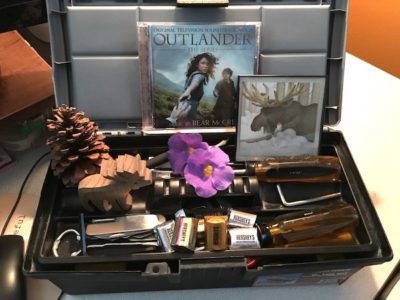
Writing is a process of total immersion into the world around me. It is not limited to the actual task of writing – pen, paper, computer, etc. To create a believable and inviting world for readers, I must first create one for myself, as a writer. I create this world by seeking out and using the senses: sight, sound, smell, taste, and touch.
Sight
I need to be able to let the reader see the world I’ve created, because I hope they’re going to be spending a significant amount of time there. I put myself physically into my story, and I can see the pine trees, the manor house, and the black cloak my character is wearing. When I see them in my mind, I do my best to describe them so that the reader can immerse themselves into the world I’ve created. At my desk, I use visible and tangible objects to help me get there – a vase of flowers, a pine cone, or a dish of shells. I might dig through my fabric stash to find just the right shade of green for a gown. Sometimes, I go outside to absorb the elements of the natural world. No, it’s not the 18th century, but there is still a sky, the land, and water. I work with those details and send them back in time to their place in my story.
Sound
The hoof beats on the gravel drive – are they those of an approaching friend or foe? Can you hear the bees moving from one flower to another in the meadow? Thunder in the distance signals an approaching storm, and my reader needs to know how it sounds – crashing, rumbling, or earth-shaking. The world is not a silent place, even at quiet times. There are always sounds of life and nature. It might be the AC kicking on, a train whistle fading in the distance, or raindrops pattering on the roof. When the world around me settles down for the night, I listen. Even then, there are things happening that create sounds to inspire and spark the imagination. At my desk, I might pop in a CD to musically transport me to a location, time, or mood that needs to be captured for my readers.
Smell
It’s hard to experience a campfire without the smell of wood smoke. How about the aroma of popcorn when you settle in to watch a movie? Ooh… what if you burn it? Can you smell rain in the air before a storm hits? Dead fish on a beach? The sensual scent of a man as he hugs you? Try closing your eyes and let your nose explore the world around you. Let it add another dimension to your story. My experiment just now rendered a hint of disinfectant (from a freshly-cleaned bathroom), chilled air from the AC vents, and French fries being baked by someone in the kitchen. I could add more, but you get the idea.
Taste
Oh my… that warm-from-the-oven chocolate chip cookie is hard to describe, but I have to try. Is that popcorn too salty? Perhaps a cold glass of iced tea will help. What does a long-awaited kiss (one you thought would never happen) taste like? A slice of lemon – did your mouth start watering? Did the same thing happen when you read the words “dill pickle?” What about the taste of blood from a dental procedure, biting the inside of your lip, or an injury caused by someone else? The jolt of cold when you take that first bite of mint ice cream…these may be familiar to many readers, but you may need to research others. (I can’t describe the taste of haggis because I’ve never eaten it.) I may need to find another way to describe something based on the story I am telling. I may want to twist things up to make the taste, though familiar, become an unexpected experience.
Touch
That green fabric I found for the gown…was it velvet or satin? Did your finger catch in a tear? How did it feel when I touched it with my hand? When I skim my hands across the surface of a glass-smooth lake, what does it feel like? Treating a skinned knee or blistered foot brings to mind any number of sensory details that surround the injury and treatment, whatever it may be. Think about sinking into a hot bath after a day of hard, physical work. The water slowly surrounds aching muscles, relaxing them and easing their pain. Readers can experience a story they can feel.
It’s hard to describe each of these senses in isolation, because most of the time they are intertwined. Sometimes it’s difficult to describe one at the exclusion of another. I may, for example, need to emphasize something’s appearance and give less attention to what it sounds like. That’s for me (the writer) to decide and work out. I dip into my well-stocked tool box that’s always close at hand.

Phyllis McKinley
Wow Anne, what inspiring writing advice written with such authenticity!
To inhabit a real world, with awareness, in order to bring it alive to the reader is always a challenge. Your piece reminded me of the words of the artist Edgar Degas, “Art is not what you see but what you make others see.” Thanks so much.
Anne
Thank you, Phyllis! I hope it was helpful!
Heather
This short piece is incredibly inspirational and will help me take my writing to a new level. Thank you.
Anne
You’re most welcome!
Ken Pelham
I like these ideas, Anne, particularly the one about bringing stimulating objects to the writing desk. I’m going to have to try that.
Anne
Thanks! Hope the ideas help! ?